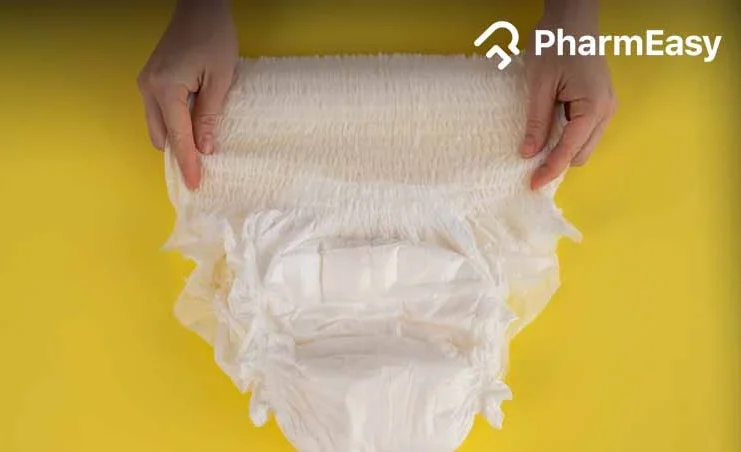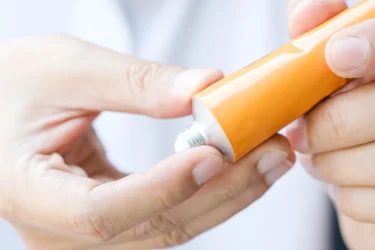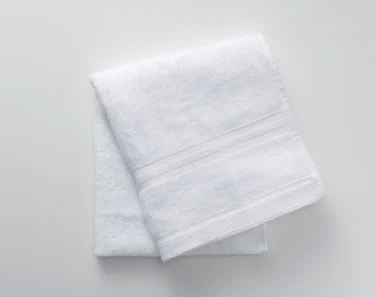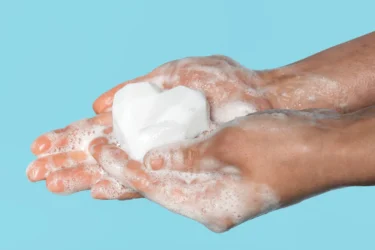Adult Diaper Rash: Causes, Symptoms, Treatment & Home Remedies
By Dr. Vishesh Bharucha +2 more

Get,

to manage your symptom
Get your,


4 Cr+ families
benefitted

OTP sent to 9988776655



You’ve successfully subscribed to receive
doctor-approved tips on
Whatsapp

Get ready to feel your best.

Hi There,
Download the PharmEasy App now!!


Register to Avail the Offer
Send OTPBy continuing, you agree with our Privacy Policy and Terms and Conditions

Hi There,
Sign up on PharmEasy now!!
Trusted by 4 crore+ families

OTP sent to 9988776655



You have unlocked 25% off on medicines




Code: NU25
By Dr. Vishesh Bharucha +2 more
Table of Contents
Diaper rash is not just a concern for babies. It can occur in adults too, and can be just as uncomfortable and frustrating. Adult diaper rash can occur due to several reasons such as incontinence (loss of urine or stool control), high moisture, or irritation to chemicals, and can get superimposed fungal (Candida albicans) or bacterial infections1.
Adult diaper rash is common, however, it is completely manageable with proper hygiene practices, topical creams, and antifungal or antibacterial treatment, though severe or chronic rashes may require medical attention1. In this article, we will explore the causes, symptoms, effective treatments, and easy home remedies that may help to soothe the skin and prevent further rashes.

Adult diaper rash (or irritant contact dermatitis), is a simple term used for inflammation of skin that develops in areas covered by diapers, pads or incontinence briefs. While there can be a combination of factors causing this condition, it most commonly occurs when your skin is exposed to prolonged moisture due to contact with stool or urine for a long period of time (thus considered as a form of incontinence-associated dermatitis). This may lead to redness (erythema), maceration, soreness, itchiness, and erosion on your skin2. However, if you notice papules (bumps) or pustules (pus-filled boils) on your skin along with erythema and erosion, it may suggest a secondary fungal or bacterial infection which occurs as a complication to adult diaper rash2,3.
Studies4 have shown that approximately 50% of adults with faecal or both (faecal and urinary incontinence) show diaper rash within two weeks.
Are you wondering what causes diaper rash in adults? In adults what is commonly called diaper rash often represents irritant or allergic contact dermatitis. It mostly occurs in individuals with incontinence due to excessive contact of skin with urine or stool, causing breakdown of skin barrier from prolonged moisture contact or pH disruption of skin, leading to inflammation. Other contributing factors include1,2,5:
By understanding the common causes of diaper rash, you can take preventive steps and choose the right care to keep your skin healthy and comfortable1,5.
Diaper rash adult symptoms include1,5,7:
Recognising these symptoms early can help prevent the rash from worsening and ensure timely treatment.
To treat diaper rash effectively, you can follow these simple home remedies for diaper rash in adults which can be remembered with the pneumonic “ABCDE”8,9:

The area of your skin should be exposed to air as much as possible. Removing your diaper may minimise the friction and contact with moisture.

Application of creams that contain zinc oxide or petroleum may help to create a barrier between your skin and the diaper, serving as a protective layer and reducing contact with urine and stool.

The skin in contact with the diaper should be cleaned gently and thoroughly with water and gentle cleansers.

You should change your diaper frequently or as soon as it is soiled. This reduces the moisture on the skin which can lead to a diaper rash. Moreover, studies have shown that individuals using disposable, breathable and absorbable diapers are found to have a lesser incidence of diaper rash compared to reusable cloth diapers8.

Diaper rash can be prevented by following simple diaper hygiene techniques such as washing your hands before and after every diaper change, using a soft cloth for cleaning, avoiding the use of irritants (such as fragrances or alcohol) in cleaning agents, use of proper fitting diapers, and monitoring for secondary infections.

Antibiotics and antifungal medication may be prescribed by the doctor if infection is confirmed. Low potency topical corticosteroids (such as hydrocortisone 0.5%) may be considered in moderate to severe inflammation. Consult your doctor and use as directed with caution, especially if you have infected skin1.
By following the simple ABCDE steps, you can effectively reduce the risk of adult diaper rash and maintain healthy, comfortable skin8,9.
Diaper rashes caused by yeast or fungal infection (commonly Candida) need special care as they may not improve with simple measures. The classical sign of fungal infection by Candida albicans is bright red erythema with satellite pustules. This helps to distinguish it from irritant dermatitis. Its treatment focuses on keeping the area clean, reducing moisture, and using antifungal medicines1.
If your rash is severe, painful, or does not improve after a few days of antifungal application, your doctor may suggest oral antifungal medicines if needed to help relieve your symptoms1.
An untreated diaper rash can lead to1,2,5,7:
You are more likely to develop these complications if you have a weak immune system or if you suffer from any chronic health conditions1,5,7.
Simple tips that you can follow to reduce diaper rash adults symptoms include1,5,9:
Always monitor your skin for signs of redness and irritation and seek medical advice early to prevent any further complications.
Also Read: Top Balance Exercises for Seniors to Improve Stability
You should see a doctor if your rash is not showing any improvement with treatment after 2 to 3 days, or if your rash spreads to other regions of your body such as your arms, face, abdomen. If you develop a fever or notice any pimples, sores filled with pus or large bumps, it is best to consult your doctor and seek prompt medical care for your condition5.
Also Read: UTI in the Elderly: Symptoms, Causes, Treatment, and Prevention
Adult diaper rash is a common yet manageable problem that can cause discomfort and irritation, if it is not treated in time. By recognizing the early signs, practicing good hygiene, and following simple care practices such as the “ABCDE” approach, you may effectively manage and reduce the risk of rashes.
In most cases, these steps are sufficient to relieve symptoms, but if the rash becomes severe, spreads to other areas, or does not improve within a few days, it is important to seek medical advice. Timely medical advice ensures proper treatment and prevents complications, keeping your skin healthy and comfortable.
Yes, taking antibiotics for a prolonged period of time can disrupt your normal skin and gut flora, thereby increasing your chances of developing fungal infections (such as Candida) that cause rashes. If you are on antibiotics and notice a rash developing, it is important to consult your doctor so that antifungal treatment can be considered10.
Stress does not directly cause diaper rash, but it can weaken your immune system and slow down healing. People under stress may also neglect proper hygiene or diaper care, which increases the risk of your rash worsening. Managing stress through relaxation techniques, exercise, or adequate rest can indirectly help the rash heal faster11.
Yes. Tight or synthetic fabrics such as nylon and polyester should be avoided as they tend to trap heat and moisture against the skin, which can worsen irritation. Loose-fitting, breathable clothing material is recommended as it allows air circulation and helps keep the diaper area dry, reducing friction and discomfort5.
The rash itself is not contagious, so it cannot spread from one person to another just by touch. However, if the rash is caused by a fungal infection (like Candida) or bacteria, those organisms may spread in shared environments or through improper hygiene. Good handwashing and proper diaper disposal reduce this risk12.
Disclaimer: The information provided here is for educational/awareness purposes only and is not intended to be a substitute for medical treatment by a healthcare professional and should not be relied upon to diagnose or treat any medical condition. The reader should consult a registered medical practitioner to determine the appropriateness of the information and before consuming any medication. PharmEasy does not provide any guarantee or warranty (express or implied) regarding the accuracy, adequacy, completeness, legality, reliability or usefulness of the information; and disclaims any liability arising thereof.
Links and product recommendations in the information provided here are advertisements of third-party products available on the website. PharmEasy does not make any representation on the accuracy or suitability of such products/services. Advertisements do not influence the editorial decisions or content. The information in this blog is subject to change without notice. The authors and administrators reserve the right to modify, add, or remove content without notification. It is your responsibility to review this disclaimer regularly for any changes.
Comments

Leave your comment...
You may also like
Comments